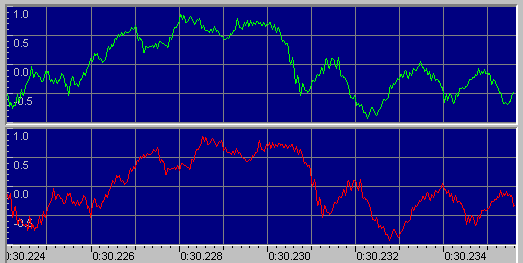
Sound takes 0.5 milliseconds to travel the distance between your two ears. If you used earphones to feed identical sounds into both ears, with the left ear receiving the sound 0.5 milliseconds before the right (see graph above), will you perceive that the sound is coming from the left? Listen to the following sound and judge for yourself:
Click here to play the sound.
(For best results, use earphones. However, you can still hear the effect if you center your head between your two speakers.)
You will hear three sound clips: a series of pure tones, a voice recording, and part of a Madonna song. Each sound clip is repeated three times. First, the right and left audio channels are identical. Second, the left channel precedes right by 0.5 ms. Third, the right channel precedes the left by 0.5 ms.
The remarkable conclusion is that it's difficult to tell which direction the pure tones are coming from, but it's easy to tell which direction a more complex sound, such as the Madonna song, is coming from.
Given that simple tones are harder to locate, why do cell phones and sirens use them? Recently, a professor from England pointed out that it would be much better to use richer sounds in such devices. See the news story and her patent. Here's a quote from the patent:
"It is known that accurate sound localization is one of the most complicated processes performed by the brain. Nethertheless, it is also known that, given appropriate cues, the brain can detect the direction of a sound source up to an accuracy of 2.degree.. This high degree of accuracy is only possible when the sound is complex and made up of a majority of frequencies in our hearing range. The brain can not locate, with any degree of spatial precision, simple pure tones. Given this knowledge it is remarkable that for decades alerting sounds in common usage, in every and any situation, for which directionality would seem an essential characteristic, are not complex enough to permit accurate localization. In other words devices which are supposed to help us localise sounds do not possess the acoustic complexity necessary for accurate localization."